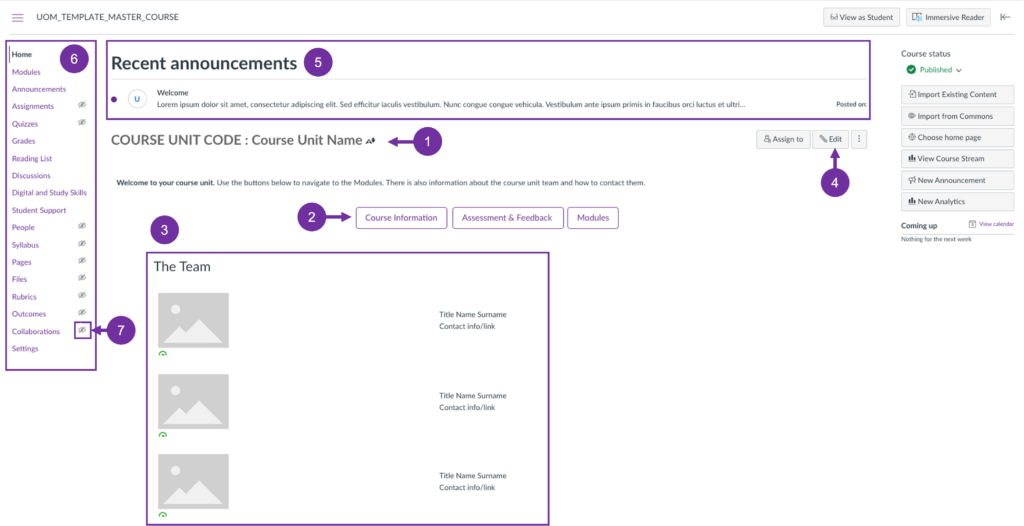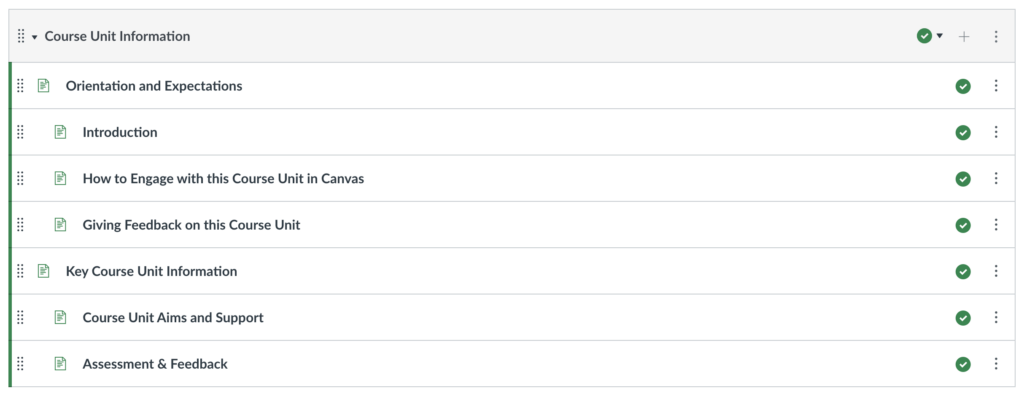Introduction
To ensure a consistent and high-quality student experience across Canvas courses, the university has developed a Canvas Course Standards Guide, co-created by teaching staff, digital learning specialists, and students.
The guide was created in conjunction with the Canvas core template. This template helps to provide a consistent structure across courses, and importantly, it can be adapted to suit the requirements of individual courses.
This guide will walk you through the core features of the template and how to customise them for your course.
The Course Homepage
The initial entry point to the course – specifically, the course homepage – follows a consistent structure, enabling students to easily navigate their learning environment, find essential information, and engage with course content without unnecessary confusion.

1 – Course Name Placeholder
This placeholder will be populated with the course’s full name, as determined from the course settings page.
2 – Links to Core Content
When clicked, these buttons redirect to the following pages:
– Course Information – Opens the Orientation and Expectations page within the Course Unit Information Module.
– Assessment & Feedback – Leads to the Assessment and Feedback page within the Course Unit Information Module.
– Modules – Directs to the Modules area.
To edit the content of these items, navigate to their corresponding locations within the course.
3 – Course Team Placeholders
Here, you should include images of the teaching staff, their names, contact information, and any other relevant details (e.g. a short biography). To edit, click the page edit button [4] and use the rich content editor to edit the images and text.
To replace an image, click the image placeholder to highlight it (a blue line will appear around the image). Next choose, insert>image. You can then choose to upload image or course images (to search for an existing image in your course unit).
4 – Edit Button
Click this button to edit the content of the homepage, including the course name and course team placeholders.
5 – Recent Announcements
The most recent announcements made in the course will be displayed here. By default, this is set the 2 most recent announcements (this can be edited from the course settings area).
6 – Course Navigation Menu
A series of links that help you and your students access different course areas. Links that are hidden from students (and therefore inaccessible) are indicated by the Visibility icon.
Note: The menu items Assignments and Quizzes will only become visible to students once content is published in these areas.
7 – Visibility Icon
Presence of this icon indicates that the link is not visible to students.
Note: The menu items Assignments and Quizzes will only become visible to students once content is published in these areas.
Course Unit Information Module
The course template includes a standard Course Unit Information module, which must be populated with relevant content in accordance with the Course Unit Standards Guide.

Expand the drop-down headings below to access detailed information about each section of the module, along with the corresponding expectations outlined in the guide.
Orientation and Expectations
This is a contents page that does not require editing. (NB: The Course information icon on the course homepage links to this page).
Introduction
This page should contain a short introduction to the course unit, along with a list of the teaching staff and details of how to arrange meetings with those teaching on the unit.
Relevant Essential Criteria
(1) An introduction to the unit
(2) The name of the module convenor and other educators, including post-graduate teaching assistants, with their roles
(3) Details of how to arrange meetings with those teaching on the unit (for example, links to office hours or bookable meetings);
Consider Including (Desirable criteria):
(1) A video or audio introduction to the course unit and the main educators
(2) A short introduction to those teaching on the unit. This could include photos or biographical details and might be a video.
(3) A course unit FAQ
(4) A ‘low stakes’ engagement activity that enables students to practice using any digital tools they will need to use in the unit
(5) An activity that starts to build a learning community
(6) An activity to ‘warm-up’ or ‘self-assess’ prior knowledge or consider student interests or motivations.
How to Engage with this Course Unit in Canvas
This page should make it clear to students how the course unit content has been designed, what is expected of them and what they can expect in return from teaching staff.
Relevant Essential Criteria:
(1) An explanation of the structure of the Course Unit in Canvas. This should include details of when material will be available to students and how those teaching will engage with the Unit in Canvas (such as expected response times to student questions and forum engagement)
(2) A statement of the expectations of student engagement (such as clarity about what is required/core and what is supplemental)
(3) An explanation of how students can ask questions
Giving Feedback on this Course Unit
This page should explain how students can give feedback on the course unit.
Relevant Essential Criteria
(1) An explanation of how students can give feedback about the course unit, including how the mid-semester feedback will be run.
(2) A summary of previous student feedback and what has changed as a result.
(3) A copy of the in-semester feedback received and the educator’s response.
Key Course Unit Information
This is a contents page that does not require editing.
Course Unit Aims and Support
This page should cover the course unit aims and reading list, as well as information around the support that’s available.
Relevant Essential Criteria
(1) A link to or copy of the Intended Learning Outcomes of the unit
(2) A link to or copy of the unit reading list
(3) A reference to the Student Support and Study Skills information – accessible via the links on the left-hand course unit navigation menu.
Consider Including (Desirable criteria):
(1) Guidance on how to best engage with the reading list (for example, prioritisation or reflective questions)
Assessment & Feedback
This page should provide a comprehensive summary of the assessment and feedback information for the unit. (NB: The Assessment & Feedback icon on the course homepage links to this page).
Relevant Essential Criteria
(1) Details of summative assessments, including weightings
(2) Details of marking criteria
(3) Deadlines for submitting summative assessments
(4) The date by when marked assessments will be returned and what will be available (e.g. provisional marks and/or feedback)
(5) Details of any formative assessment and how feedback will be provided
(6) Information about how and where to submit assessments. This should be available from the beginning of the unit (this can be a holding message with date of when it will go live)
(7) A forum for asking questions in which answers are visible to all students and educators on a unit.
Consider Including (Desirable criteria):
(1) A video screencast narrating the assessment information.
(2) Assessment exemplars, or an example of a similar assessment
Course Navigation Menu
The Course Navigation Menu has been pre-configured as part of the template. To streamline content and improve the student experience, certain items are hidden from students by default, preventing access to tools and information that may be unnecessary or irrelevant. By default, only the following course links will be available to students; Home, Modules, Announcements, Assignments*, Quizzes*, Grades, Reading List, Discussions, Digital and Study Skills and Student Support.
*These menu items will become visible to students once assignments and quizzes are published in your course unit.
Remember, course content and links should primarily be delivered through the Modules page. This ensures a clear, structured learning path, making it easier for students to navigate and access materials in a logical sequence. Avoid relying on the course navigation menu for content delivery, as this can lead to confusion and inconsistency.